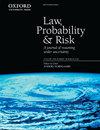Defence against the modern arts: the curse of statistics: Part I—FRStat
IF 1.4
4区 社会学
Q1 LAW
引用次数: 3
Abstract
For several decades, legal and scientific scholars have argued that conclusions from forensic examinations should be supported by statistical data and reported within a probabilistic framework. Multiple models have been proposed to quantify and express the probative value of forensic evidence. Unfortunately, the use of statistics to perform inferences in forensic science adds a layer of complexity that most forensic scientists, court offices and lay individuals are not armed to handle. Many applications of statistics to forensic science rely on ad hoc strategies and are not scientifically sound. The opacity of the technical jargon that is used to describe these probabilistic models and their results, and the complexity of the techniques involved make it very difficult for the untrained user to separate the wheat from the chaff. This series of article is intended to help forensic scientists and lawyers recognize limitations and issues in tools proposed to interpret the results of forensic examinations. This article focuses on the tool proposed by the Latent Print Branch of the U.S. Defense Forensic Science Center (DFSC) and called FRStat. In this article, I explore the compatibility of the results outputted by FRStat with the language used by the DFCS to report the conclusions of their fingerprint examinations, as well as the appropriateness of the statistical modelling underpinning the tool and the validation of its performance.防御现代艺术:统计的诅咒:第一部分- frstat
几十年来,法律和科学学者一直认为,法医检查的结论应该得到统计数据的支持,并在概率框架内报告。人们提出了多种模型来量化和表达法医证据的证明价值。不幸的是,在法医科学中使用统计数据进行推理增加了一层复杂性,这是大多数法医科学家、法院办公室和非专业人员无法处理的。统计学在法医学中的许多应用依赖于特别的策略,在科学上是不合理的。用于描述这些概率模型及其结果的技术术语的不透明性,以及所涉及的技术的复杂性,使得未经训练的用户很难将小麦从谷壳中分离出来。本系列文章旨在帮助法医科学家和律师认识到用于解释法医检查结果的工具的局限性和问题。本文的重点是美国国防法医科学中心(DFSC)的潜在指纹分支提出的工具,称为FRStat。在本文中,我探讨了FRStat输出的结果与DFCS报告其指纹检查结论所使用的语言的兼容性,以及支持该工具的统计建模的适当性及其性能的验证。
本文章由计算机程序翻译,如有差异,请以英文原文为准。
求助全文
约1分钟内获得全文
求助全文
来源期刊

Law Probability & Risk
MATHEMATICSSTATISTICS & PROBABILITY&-STATISTICS & PROBABILITY
CiteScore
2.10
自引率
28.60%
发文量
8
期刊介绍:
Law, Probability & Risk is a fully refereed journal which publishes papers dealing with topics on the interface of law and probabilistic reasoning. These are interpreted broadly to include aspects relevant to the interpretation of scientific evidence, the assessment of uncertainty and the assessment of risk. The readership includes academic lawyers, mathematicians, statisticians and social scientists with interests in quantitative reasoning.
The primary objective of the journal is to cover issues in law, which have a scientific element, with an emphasis on statistical and probabilistic issues and the assessment of risk.
Examples of topics which may be covered include communications law, computers and the law, environmental law, law and medicine, regulatory law for science and technology, identification problems (such as DNA but including other materials), sampling issues (drugs, computer pornography, fraud), offender profiling, credit scoring, risk assessment, the role of statistics and probability in drafting legislation, the assessment of competing theories of evidence (possibly with a view to forming an optimal combination of them). In addition, a whole new area is emerging in the application of computers to medicine and other safety-critical areas. New legislation is required to define the responsibility of computer experts who develop software for tackling these safety-critical problems.
 求助内容:
求助内容: 应助结果提醒方式:
应助结果提醒方式:


